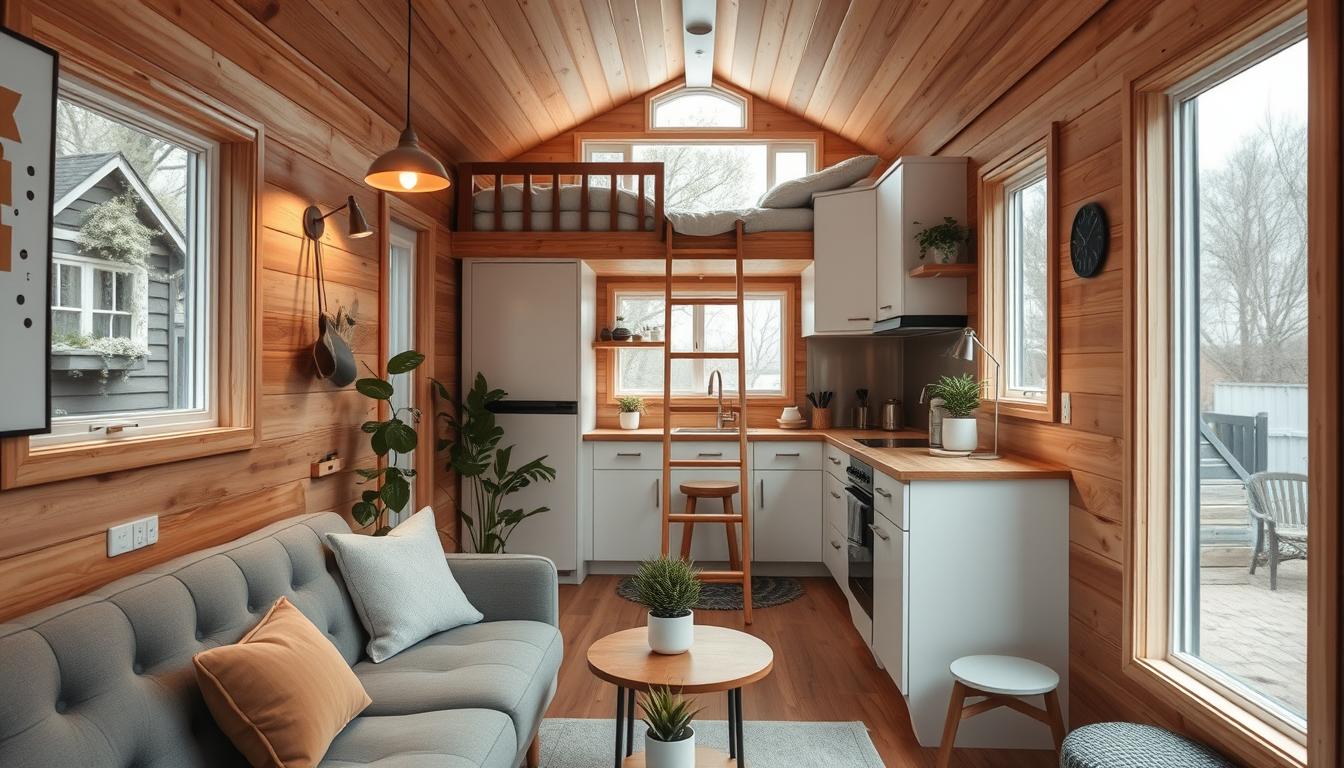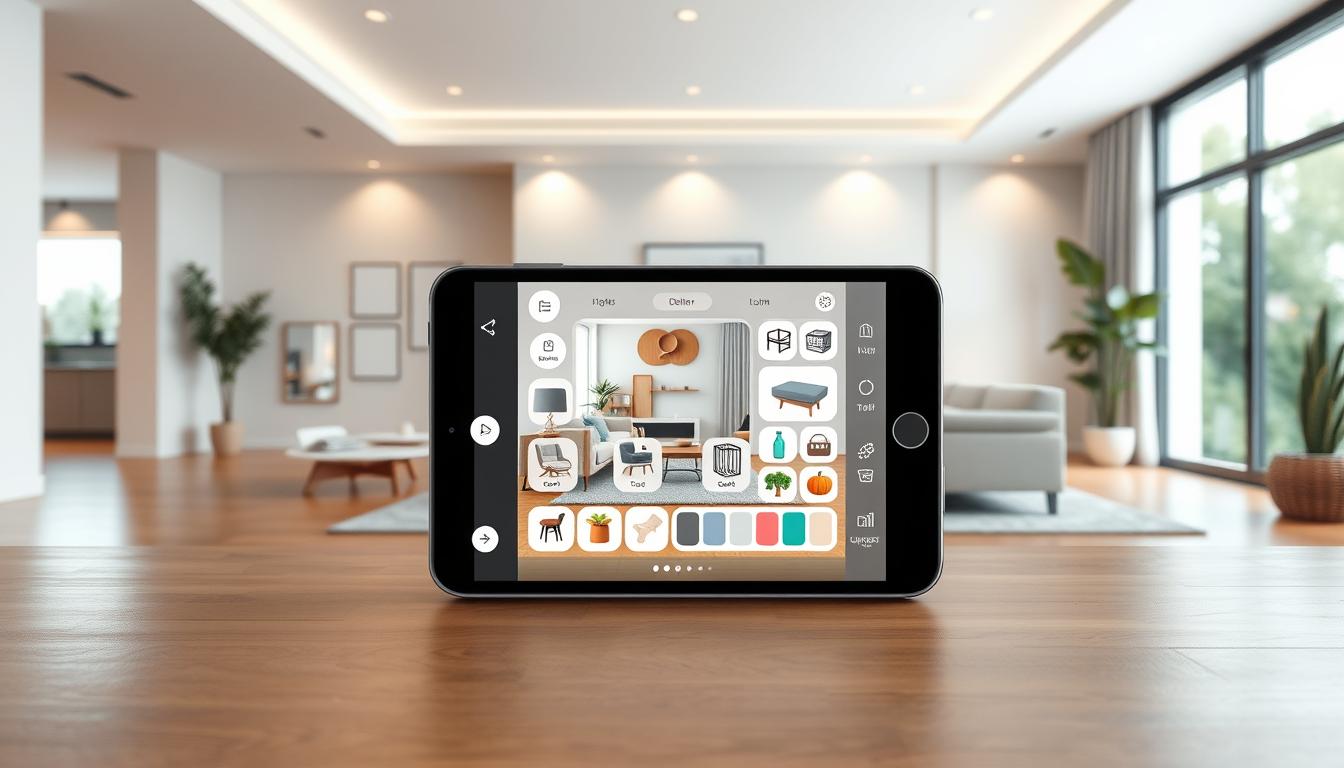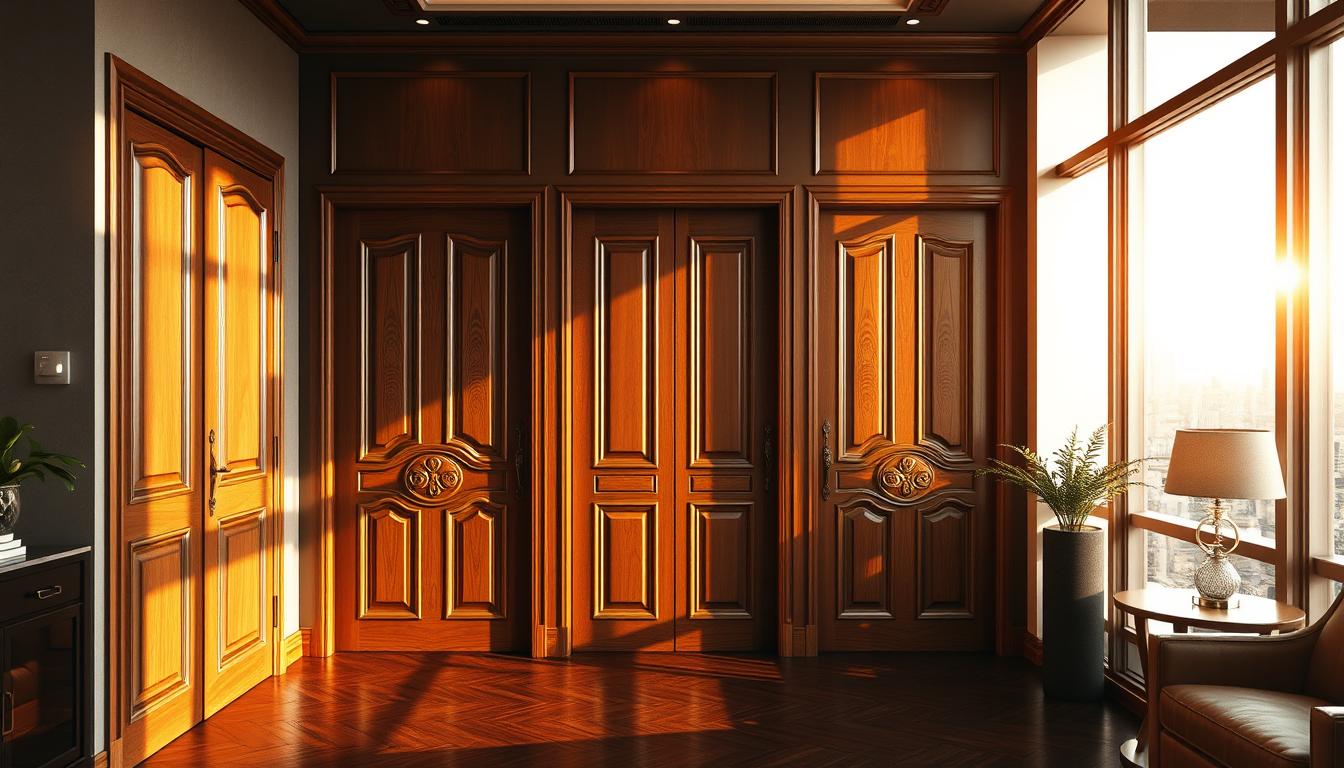The trend of living in compact spaces is growing fast. Over 10,000 tiny homes now live in the United States. As more people choose this lifestyle, the need for smart and stylish tiny home interior designs is rising.
We get the challenge of making the most of small spaces. We’re here to offer our best advice. In this article, we’ll show you how to turn your tiny home into a cozy and useful tiny house decorating ideas space.
Key Takeaways
- Maximizing storage space in small homes
- Selecting the right furniture for compact living
- Utilizing light to enhance the sense of space
- Creating a functional layout
- Incorporating multi-functional elements
Understanding the Tiny Home Concept
The tiny home lifestyle promises a simpler life with less clutter. Every part of the home has a purpose. Let’s dive into what tiny homes are, their benefits, and common myths.
What is a Tiny Home?
A tiny home is usually under 400 square feet. They are built to be efficient, with every detail thought out. This makes them functional.
These homes can move on wheels or sit on a foundation like regular houses. They often use minimalistic home decor. This means they focus on simplicity and removing what’s not needed.
Benefits of Living in a Tiny Home
Living in a tiny home has many perks. You can save money, live more sustainably, and have less to clean. It lets you focus on what’s important.
It also promotes a minimalist lifestyle. This helps people declutter and focus on what they really need.
Common Misconceptions about Tiny Living
Many think tiny homes are cramped or uncomfortable. But, with good design, they can be cozy and roomy.
Some also believe tiny homes aren’t good for families or long-term living. But, many families and individuals live happily in tiny homes. They enjoy the simpler, more efficient life.
Key Design Principles for Tiny Spaces
To make a tiny space cozy and functional, we need to know and use key design principles. Designing a tiny home involves several factors. These help make the space feel big and comfortable.
First, we embrace minimalism. A clean space looks better and feels bigger. Minimalism is about simplicity and functionality. It lets us enjoy our space without clutter.
Embracing Minimalism
In tiny homes, minimalism means choosing items carefully. We pick furniture and decor that do more than one thing. For example, a storage ottoman can be a seat and a place to store things.
“The ability to simplify means to eliminate the unnecessary so that the necessary may speak.” – Hans Hofmann
By being minimalist, we make our tiny home more livable.
The Importance of Functionality
Functionality is key in small spaces. Every piece of furniture and design element must have a purpose. Space-saving furniture is great because it keeps the space clean while still being useful.
| Furniture Type | Functionality | Space-Saving Feature |
|---|---|---|
| Murphy Bed | Sleeping | Folds up against the wall |
| Nesting Tables | Surface for working or dining | Nests together when not in use |
| Storage Ottoman | Seating and storage | Stores items inside |
Creating Visual Flow
To make a tiny space feel larger, we need to create a visual flow. We do this by using the same colors, arranging furniture to guide the eye, and adding elements that connect the space.
By thinking about these design principles, we can make a tiny home that feels big, comfy, and looks good.
Choosing the Right Color Palette
When designing a micro home interior, picking the right colors is key. The colors you pick can greatly change how big or small your tiny home feels.
We’ll look at how colors affect space in tiny homes. We’ll talk about the good and bad of light and dark colors. Plus, how accent colors can bring life to your small space.
Light vs. Dark Colors
Light colors are often suggested for tiny homes. They reflect light, making spaces feel bigger and more open. White, beige, and pale gray are favorites for walls and ceilings. They help spaces feel airy and connected.
Dark colors, on the other hand, can make a room feel cozy and intimate. But, too much of them can make a tiny home feel tight. Dark colors soak up light, making spaces seem smaller.
How Colors Affect Perception of Space
Colors play a big role in how we see space. For example, using the same color everywhere can make a tiny home feel bigger. But, too many colors can make it feel cramped.
The finish of the color also matters. Glossy finishes bounce light, making spaces feel larger. Matte finishes, on the other hand, absorb light, making them cozier.
Accent Colors for a Vibrant Touch
Accent colors can add personality and energy to your tiny home. A bold accent color used wisely can create eye-catching focal points.
When picking accent colors, think about your overall color scheme. A bright color can add life if your main colors are neutral. For instance, a bold color in furniture or decor can brighten up a neutral space.
By carefully choosing your colors, you can make your tiny home feel more spacious. You can also create a welcoming space that shows off your style.
Smart Space-Saving Furniture Solutions
In tiny homes, every inch matters. The right furniture can make a small space cozy and useful. It’s all about choosing furniture that does more than one thing.
Multipurpose Furniture Options
Multipurpose furniture is a big help in tiny homes. It does more than one job, saving space. For example, storage ottomans are seats and storage all in one. Murphy beds fold up against the wall, freeing up space.
Dining tables with built-in storage are also smart. They have drawers or shelves for dishes and utensils. This keeps your dining area tidy and organized.
Foldable and Expandable Designs
Foldable and expandable furniture is perfect for tiny homes. It can be tucked away when not needed, making room for other activities. Foldable chairs and drop-leaf tables are great for saving space.
Expandable designs, like extendable tables, grow to fit more people. Then, they shrink back down when you need the space for something else.
Utilizing Vertical Space
Using vertical space is key in tiny homes. It lets you make the most of the space from floor to ceiling. Loft beds offer a place to sleep without taking up floor space.
Wall-mounted shelves and storage units keep things organized and off the floor. This makes your space feel bigger and more open.
| Furniture Type | Space-Saving Feature | Benefit |
|---|---|---|
| Storage Ottomans | Storage and Seating | Reduces clutter and provides additional seating |
| Murphy Beds | Folds up against the wall | Creates floor space when not in use |
| Foldable Chairs | Folds up for storage | Easily stored away when not in use |
Layout Strategies for Tiny Homes
Effective layout strategies are key for tiny homes, where every inch matters. A well-thought-out layout can greatly enhance the feel of space and comfort in a tiny home.
Open Concept vs. Defined Areas
Choosing between an open concept or defined areas is a big decision for tiny homes. Open concept layouts can make a home feel larger by removing walls. This creates a smooth flow and sense of continuity.
Defined areas, on the other hand, offer privacy and separation. We can use furniture or partial walls to create different zones within the home.
Zoning with Furniture Arrangement
Furniture arrangement is vital for zoning in tiny homes. By choosing and placing furniture wisely, we can set up distinct areas for living, dining, and sleeping. This is done without needing separate rooms.
For example, a sofa can act as a divider between the living area and other parts of the home. A loft bedroom can be reached by a ladder or stairs that also serve as storage.
Flow of Movement
The flow of movement is crucial in tiny home layouts. A good layout should allow for easy movement, ensuring the homeowner feels comfortable and not cramped.
To achieve this, we need to think about the “traffic path” through the home. Furniture should be placed to keep this path clear. Using multi-functional furniture can also help avoid blocking movement.
| Layout Strategy | Benefits | Considerations |
|---|---|---|
| Open Concept | Makes space feel larger, promotes flow | Can lack privacy, may feel too open |
| Defined Areas | Provides privacy, delineates different zones | Can make space feel smaller, requires careful furniture placement |
| Zoning with Furniture | Creates functional areas without walls | Requires multi-functional furniture, careful planning |
By exploring these layout strategies, we can design a tiny home that is both functional and cozy. This makes the most of the available space.
Maximizing Storage in Tiny Homes
In tiny homes, every inch is precious. Clever storage solutions can make a big difference. We’ll explore creative ways to use the space you have.
Creative Storage Solutions
Multipurpose furniture is a great way to boost storage. For example, a storage ottoman can be a seat and a place to store things. Beds with drawers or shelves also help keep things tidy.
Wall-mounted storage, like shelves or cabinets, is another smart choice. It keeps things off the floor and makes your home feel more open.
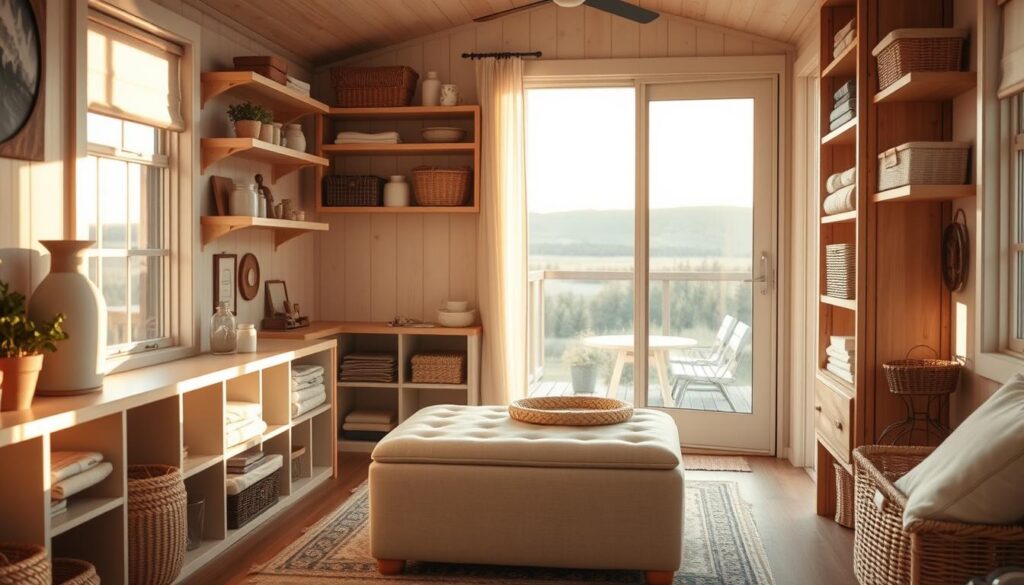
Utilizing Underutilized Areas
Look for spaces that are often ignored, like under the bed or the back of a door. Bed risers or storage bins can turn the space under your bed into useful storage. Over-the-door racks are great for hanging jackets, bags, or cleaning supplies.
Don’t forget about the ceiling. Installing overhead storage or hanging plants can make the most of your vertical space. It keeps your belongings organized and out of the way.
Decluttering for a Streamlined Space
Decluttering is key to keeping your tiny home tidy. Regularly go through your belongings and get rid of what you don’t need. This prevents clutter from building up.
Start by sorting items into three piles: keep, donate/sell, and discard. Be honest with yourself about each item’s purpose. Let go of things that no longer have a use.
Storage Solutions Comparison
| Storage Solution | Benefits | Space Requirement |
|---|---|---|
| Multipurpose Furniture | Serves multiple purposes, reduces clutter | Low to Moderate |
| Wall-Mounted Units | Frees up floor space, creates openness | Low |
| Underbed Storage | Utilizes underutilized space, keeps items hidden | Low |
By using creative storage, making the most of hidden spaces, and keeping things tidy, you can enjoy a more organized and peaceful tiny home.
Décor Tips for Personalizing Tiny Interiors
To make your tiny house feel like home, focus on décor that shows who you are. Personalized décor makes your space welcoming and boosts its beauty.
Choosing Décor that Reflects You
When picking décor for your tiny home, choose items that match your style. This could be artwork, collectibles, or furniture that tells a story. For example, if you love to travel, showing off souvenirs or maps can add a personal touch.
Exploring tiny home interior design ideas can help inspire your choices.
Balancing Style with Space
Decorating a tiny home can be tricky because of the small space. To solve this, choose items that do more than one thing. For instance, a storage ottoman can be a seat and a place to store things.
Also, pick décor that has a double purpose, like a wall-mounted shelf that adds storage and looks good. This helps keep your space tidy and stylish.
Incorporating Nature and Greenery
Adding nature to your tiny home décor can make it feel bigger and more connected to the outdoors. Plants are a great way to bring in a natural feel. Pick easy-to-care-for plants like succulents or air plants.
Using natural materials, like woven baskets or reclaimed wood wall art, can also warm up your tiny home.
By following these décor tips, you can make your tiny home stylish and personal. Remember, the secret to great tiny home decorating is to be thoughtful with your choices and focus on both looks and function.
Lighting Solutions for Cozy Ambiance
The right lighting can really change a small space. It can turn it into a warm and inviting home.
Maximizing Natural Light
Natural light is key in tiny homes. It makes the space feel bigger and more open. We can use sheer curtains or blinds to let sunlight in while keeping privacy.
Also, placing mirrors opposite windows can reflect light. This makes the home feel even bigger.
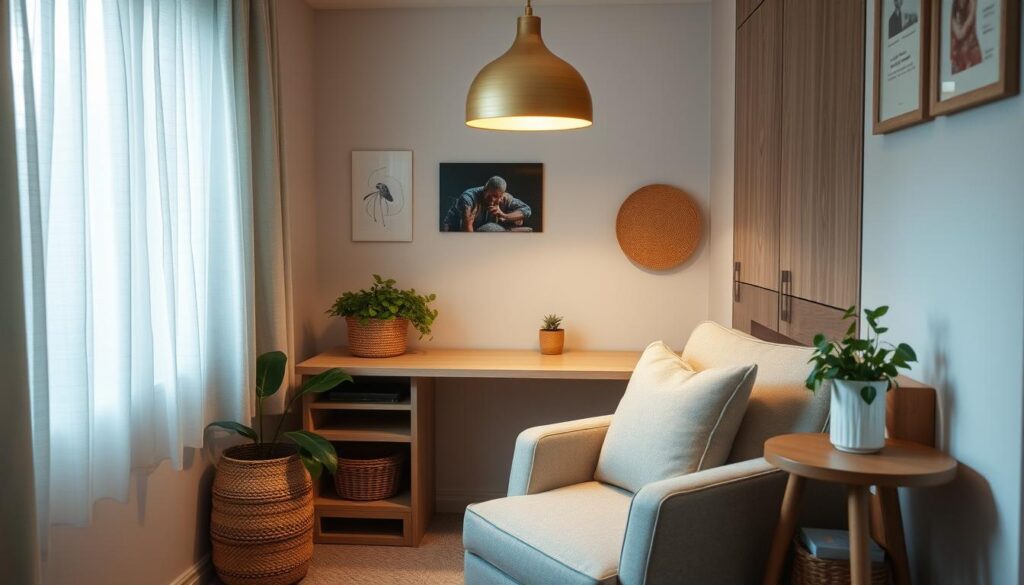
Layering Light Sources
Using different light sources is important for a cozy feel in small spaces. We mix overhead lighting, table lamps, and floor lamps for a warm atmosphere.
For example, overhead lights give general light. Table lamps add focused light, making areas feel cozy and comfortable.
“Good lighting is not just about visibility; it’s about creating an atmosphere that makes you feel comfortable and relaxed in your home.”
Heightening the Space with Lighting
Lighting can make tiny homes feel bigger. Using light colors and reflective surfaces tricks the eye into seeing more space.
LED strip lights under furniture or along baseboards also add depth. This makes the space feel more open.
| Lighting Technique | Description | Benefit |
|---|---|---|
| Layering | Combining overhead, table, and floor lamps | Creates a warm and inviting atmosphere |
| Reflective Surfaces | Using mirrors and light colors | Enhances the sense of space |
| Accent Lighting | Highlighting specific features or areas | Adds depth and visual interest |
By using these lighting tips, we can make our tiny homes cozy and welcoming. They will feel more spacious and comfortable.
Future Trends in Tiny Home Interior Design
Looking ahead, tiny home interiors will get a big upgrade. They will be more sustainable and cozy. We’re seeing a move towards designs that are good for the planet and feel like home.
Sustainable Materials and Technologies
Using eco-friendly materials is becoming a big deal in tiny homes. Think reclaimed wood, recycled stuff, and energy-saving gadgets. This trend is here to stay, thanks to our growing love for the environment.
Innovations in Smart Tiny Homes
Technology is changing tiny home interiors for the better. Things like smart lights and temperature control are making life easier. These tech advancements are making tiny homes more attractive to everyone.
The Rise of Tiny Living
Tiny living is getting more popular. It’s affordable, simple, and good for the planet. As more people try it, we’ll see even more cool designs in tiny homes. They’ll be both stylish and practical.

